Why ‘Morning yoga for office goers’? Well, majority of us lead a sedentary lifestyle today, mostly because of our sitting jobs. Believe it or not, but sedentary lifestyle slowly and gradually affect our lives adversely. Sitting jobs are commonly known as “The new smoking.” In fact, many research shows that highly sedentary lifestyle can lead to many diseases such as heart disease and diabetes, among other serious health problems. Morning yoga for office goers can help you balance your work and health.
Sitting at a desk for a whole day can contribute to tightness in the lower body regions such as hips and legs, in addition to neck, shoulder and back pain and discomfort. Also, it contributes to unhealthy posture. A lot of negative physical reactions start to take place when the body is not in movement.
Morning yoga for office goers can be an effective antidote to many desk-job ailments. Starting your day by connecting to your body and breath will help you create a positive and meaningful day ahead. Yoga helps you balance your mind, body, spirit, and breathe into one line, thereby making your life happier, calmer, harmonious and more fulfilling.
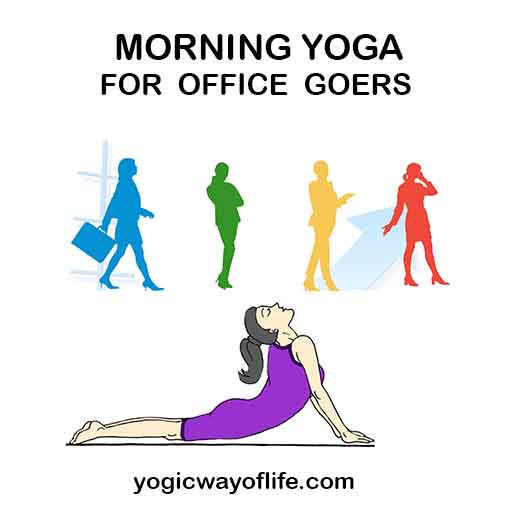
Morning time is considered the most sacred time for practicing yoga. By incorporating morning yoga for office goers into your life you would be able to mark phenomenal changes in your life. Waking up early in the morning, performing morning yoga poses in the fresh air helps create a sense of union, allows your body to control its sleep rhythms, and invigorate the functions of the organs, thereby ensuring a peaceful mind and healthy body.
Here is a list of morning Yoga Asanas for office goers that will help you have great health benefits, just 15 minutes of your routine and you are done.
Downward Facing Dog Pose or Adho Mukha Svanasana
Adho Mukha Svanasana or the downward facing dog pose stretches and straightens the spine. In Sanskrit, Adho means down, Mukha means face and Svana means a dog. It energizes and rejuvenates your entire body, including your mind. Here are the steps:
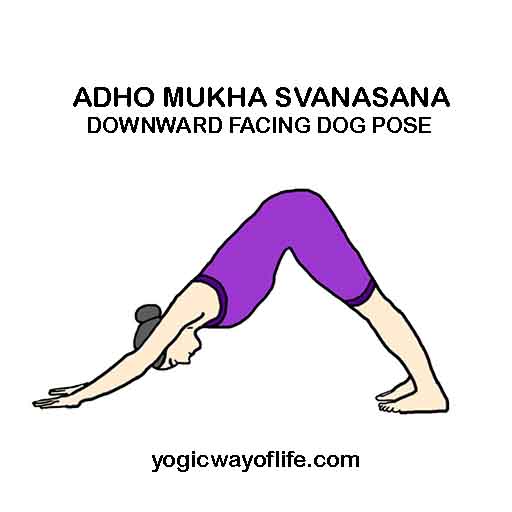
- Start with the kneeling position and place your palms on the floor in front of you.
- Let your palms be spread out on the mat. The knees should be preferably behind the tailbone to get a good stretch.
- Slowly raise your knees and straighten it out. Your legs will be straight and the weight of the body will be supported by your palms and feet.
- Now stretch your heels and the thigh muscles while straightening the legs.
- Tuck your belly in and push the chest slightly towards the floor while straightening the spine.
- Make sure the heels are touching the floor.
- Place your head between the inner-side of the upper arms and look down towards the floor. This is the final pose. Breathe normally in this position. Maintain the position for as long as you are comfortable.
- To release the pose, come back to the kneeling position and relax your back and arms.
Palm Tree Pose or Tadasana
Tadasana or Palm Tree Pose. It stretches and lengthens your muscles leading to the stimulation of the entire body.
In Sanskrit, Tada means Palm Tree, and asana means posture. This pose is created by observing palm tree. Hence, it is called mountain pose. Here is how to perform Tadasana
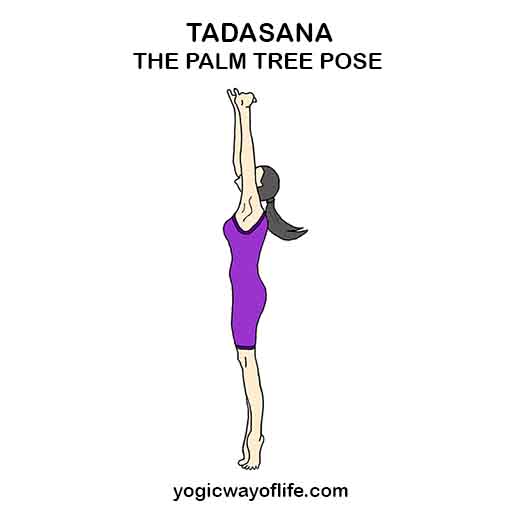
- Stand straight on the ground with a small gap between your feet.
- Interlock your fingers
- Take a deep breath and with that raise both your arms.
- Stretch your arms upward let your fingers be interlocked.
- Raise your heels simultaneously stand on toes.
- Feel the pressure of stretching from top to bottom.
- Be in pose for few seconds keep breathing slowly and deeply.
- Now exhale and come to the original position.
- The number of rounds can be performed as per your convenience.
Ardha Chakrasana or Half Wheel Pose
Ardha Chakrasana or Half Wheel Pose is an amazing yoga asana for those who have a stiff back. This yoga posture is good for flexibility of the back and neck. Ardha Chakrasana strengthens the back and tones the organs in the abdomen including the digestive, excretory and reproductive organs.
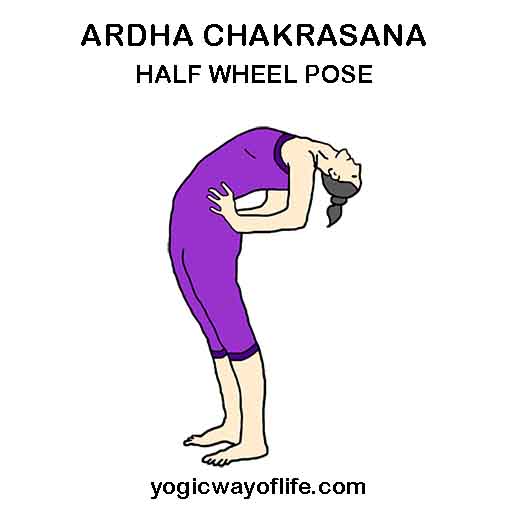
In Sanskrit, Ardha means half, Chakra means wheel and Asana means a pose. Here is how to perform Ardha Chakrasana:
- Stand straight and bring your hands together in a clasped position.
- Raise and rotate your hands above the shoulders.
- Slowly bend the upper part of your body along with the hands, as far as you can go.
- Remain in this position for a few seconds to a minute, according to your capacity.
- To release the pose, bring back slowly to the standing position with hands on your side.
- There is a variation of Ardha Chakrasana, where the hands are placed behind the hips and then the back bending is attempted.
Standing Side Bend Pose or Ardha Kati Chakrasana
Besides clearing the blockages in the lungs and improve breathing, this asana is very good for Reducing the fat from the waist and tone it. Ardha Kati Chakrasana Improves flexibility of the hips.
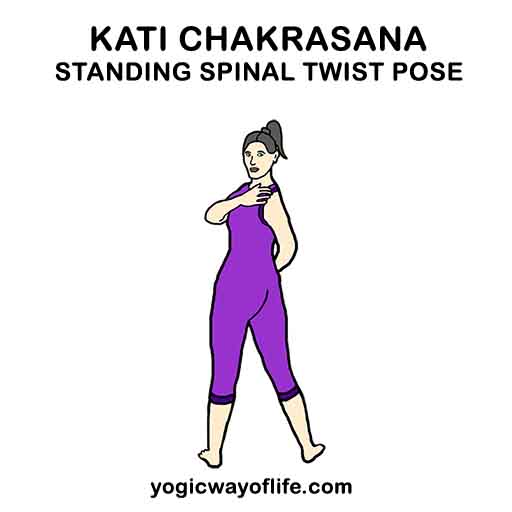
In Sanskrit, Ardha means half, Kati means waist, Chakra means wheel, and Asana means pose. Here is the procedure to perform this asana:
- While you inhale, slowly raise the right arm side-ways up.
- Stretch the arm with deep inhalation vertically until your biceps touches the right ear, your palm should face the left side.
- Now exhale and bend your trunk slowly to the left.
- Slide down your left palm along the left thigh as far as possible.
- Keep your right elbow and right knees straight, do not bend them.
- Continue in this pose and Keep breathing normally.
- For releasing the pose, slowly come back to vertical position inhale and stretch the right arm up. Feel the pull along a straight line from the waist up to the fingers.
- As you exhale, bring the right arm down to standing position.
- Now repeat this on the left side, by bending towards the right side.
Cat-Cow Pose or Marjariasana / Bitilasana
Next post is Cat-cow pose or Marjariasana / Bitilasana, it provides a gentle massage to your spine. The gentle movement when coordinated with the breath stimulates the belly organs and calms the brain. Here are the steps to perform Cat Cow pose:
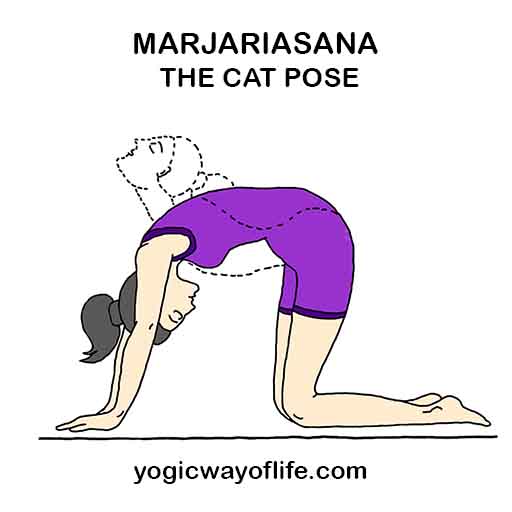
- Start on your hands and knees in a tabletop position.
- Your knees should be directly below your hips and your wrists, elbows and shoulders should be in line and perpendicular to the floor.
- Strongly press your palms into the ground and broaden your shoulders and keep the head in a neutral position.
- For Cow Pose: take a deep breath and drop the stomach towards the floor, while uplifting your chest and chin fix your gaze towards the ceiling.
- For Cat pose: Breath out, arch your back towards the sky, pull your stomach to your spine, and touch your chest with chin.
- Coordinate the movement sand flow from cat to cow and vice-versa with inhalation and exhalation.
Child Pose or Balasana
Balasana or the Child’s Pose is an excellent resting pose. In Sanskrit, Bala means Child and Asana means yoga pose. This asana or pose has been created by observing young children. This pose deeply calms your mind, lengthens the back body, hips and reduces fatigue. Here is how to perform:
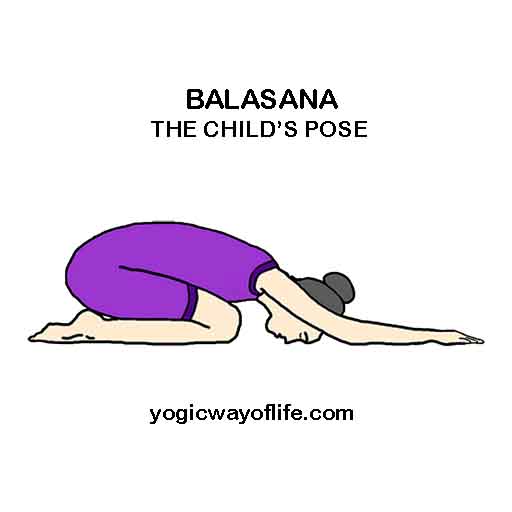
- Start with the kneeling position. Keep the feet and toes together.
- Now, spread your knees slightly apart. Inhale slowly and deeply.
- Slowly bend forward and let your chest rest between the thighs. Exhale as you are bending down. Let your hands be in front of you and resting on the floor, palms facing the mat.
- Adjust your pelvis and sacrum in such a way that your abdomen rests between the inner thighs and the back is stretched forward.
- The forehead should rest on the floor and palms facing downwards, fully touching the mat. The arms should be in line with the knees and fully stretched out and relaxed. If you have difficulty resting the forehead on the floor, you may use a pillow for support.
- Breathe normally in this position and feel the deep relaxation. Remain in this position for as long as you are comfortable.
- To release the pose, move your hands back and slowly raise yourself up to the kneeling position.
The Cobra Pose or Bhujangasana
Bhujangasana or the Cobra Pose, is one of the main backward bending asanas used in yoga. In Sanskrit, Bhujanga means a cobra. Bhujangasana is easy to perform and is also integrated into other yoga practices like the Surya Namaskara, it is the 8th pose in the series of 12 poses. Here are the steps:
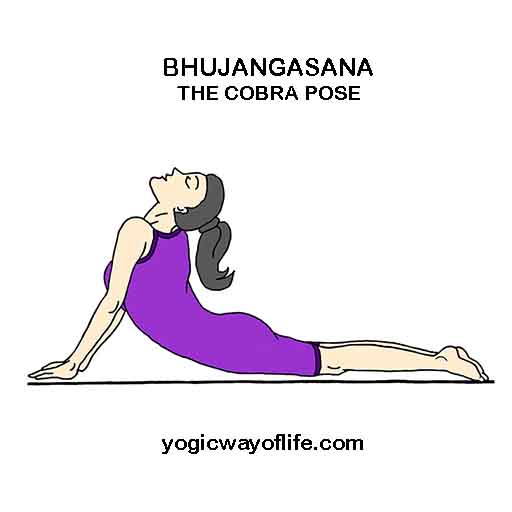
- Lie down on your belly with chin touching the ground.
- Place your hands close to the shoulders with palms touching the ground
- Keep your legs straight.
- Press your palms firmly against the floor.
- As you inhale, lift up your trunk, using your palms as support.
- Gaze towards the ceiling and let your hips be steady.
- Hold the pose for 15-30 seconds and then exhale and release the pose.
Boat Pose or Naukasana
Navasana or Naukasana provides you with core strengthening and toning benefits. In Sanskrit, Nauka means boat and Asana means pose. This pose is created by observing a boat. Here is how to perform it:
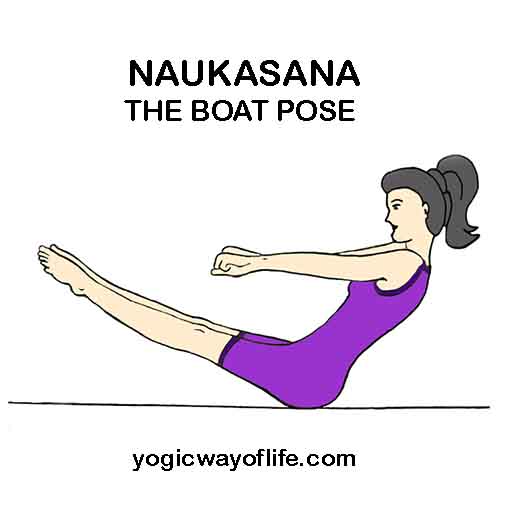
- Lie on your back on the mat.
- Relax your shoulder and rest your arms on either side of your body.
- Bend your knees, feet resting on the mat.
- Inhale and lift the feet from the mat.
- As you exhale, straighten your leg and engage your core. Keep your arms straight.
- Take a deep inhalation and lift the torso and head from the mat, allowing your body to come into a V. Relax your head, neck, and shoulders.
- Engaging your core muscles and keeping your legs and hand active, hold the posture for seven deep breaths.
- Exhale and release the feet down. Recline on your back and relax.
Corpse Pose or Shavasana
Your morning yoga poses should be concluded with Shavasana. In Sanskrit, Shava means Corpse. This Asana is created by observing corpse. Shavasana is the best asana to calm your mind, release any kind of stress in the body and sink in all the asanas at a deeper level. Here is how to perform Shavasana
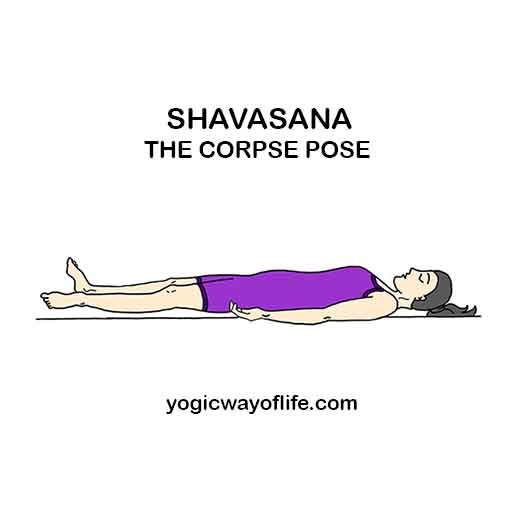
- Lie down on your back.
- Legs spread apart
- Place your arms beside your body facing upwards.
- Take deep breaths
- Stay in the pose for at least 2 minutes and then release the pose.
Pranayama or Breathing Practice
Finally, performing pranayama after the yoga session is very good for one’s overall health. Prāṇāyāma is an art of conscious breathing, it comprises two Sanskrit words: Prana which means “life force or breath,” and Ayama “techniques of intentionally altering the breath to produce specific results.” It is the fourth limb of Ashtanga yoga.
Pranayama is an excellent breathing exercise for overall health. It helps you release any kind of anxiety and strengthens your energy positively. Pranayama is a great way of energizing the body and mind simultaneously. Perform these two pranayams to conclude your Morning yoga for office goers.
Bhastrika Pranayama
It involves forceful inhalation and exhalation of breath. This pranayama technique increases the level of oxygen in the blood. Steps to perform Bhastrika Pranayama:
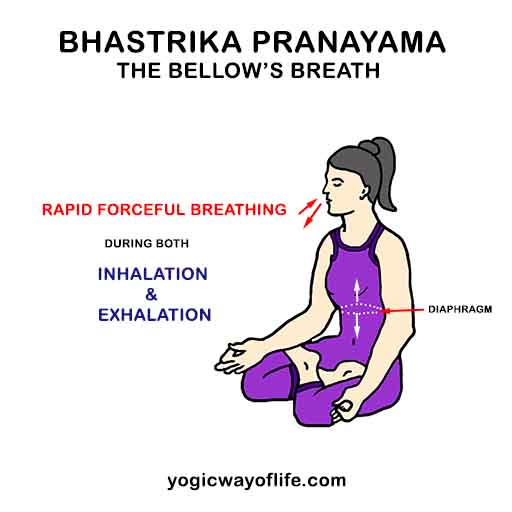
- Sit in Padmasana (Lotus Pose) with your spine straight.
- Take a deep breath and fill your lungs with air.
- Count till five, and then release the breath.
- Now, begin practicing the technique by inhaling and exhaling with force.
- There will be a panting sound while you will perform it with force.
Practice for 1 – 2 minutes.
*One round of inhalation and exhalation will count as one time.
Kapalbhati Pranayama
A great way to detoxify the body, as, the technique helps in expelling carbon-di-oxide from the blood. This breathing technique needs minimal effort, however, comes with a plethora of benefits. Steps of Kapalbhati Pranayama:
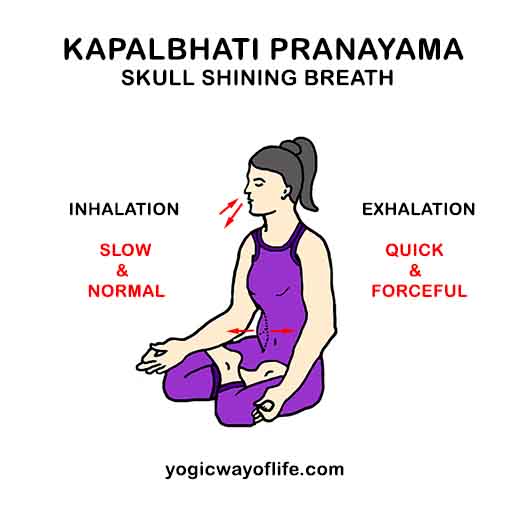
- Sit in Padmasana (lotus pose) and close your eyes and keep your spine straight.
- Now, take a deep breath through your both nostrils until you fill your lungs with air.
- Now, forcefully exhale through both nostrils, so your stomach will go deep inside.
- While exhaling you will feel some pressure in your stomach and there will be a hissing sound.
Repeat this process for 1 – 2 minutes.
Performing pranayama after your yoga pose is the perfect antidote to a long, stressful day. Pranayama helps you release tension in body and mind. Also, it helps us relieve stress and anger and help us to have more balanced and clear state.
Benefits of Morning Yoga for Office Goers
Incorporating morning yoga for office goers will help you have following benefits:
- Brings clarity of mind
- Calm the mind and body
- Removes lethargy
- Improves your digestion
- Improves energy level that keeps you going for the whole day
- Last but not least, help you start your day with a happy note.
